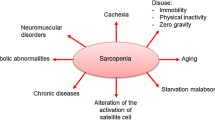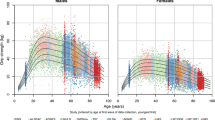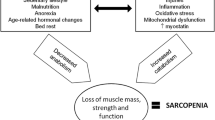Abstract
Sarcopenia is an evolving concept and the current definition of sarcopenia includes both a loss of muscle strength and loss of muscle mass. However, despite the increasing knowledge and improved technology, a worldwide operational definition of sarcopenia applicable across racial/ethnic groups and populations lacks consensus. As a result the prevalence of sarcopenia (8 to 40% of older people over 60 years) varies depending on the study sample (namely the age of the sample), the definition, and the assessment tool used. DXA is the main assessment method used to evaluate muscle mass, which is further adjusted to height, weight fat mass, or BMI to obtain an index of sarcopenia. Cross-sectional analyses seemed to prove an association between low muscle mass and functional decline, but these results were not consistent when analysed longitudinally over time. This inconsistency could be due to methodological issues as the selected populations in the cohorts where autonomous, community-dwelling, older people. In this highly active population decreases in muscle mass might be not as important as decreases in strength to predict functional decline. The aim of the present paper was to perform a comprehensive review of the literature on the epidemiology of sarcopenia and its consequences to be presented on November 13th and 14th 2008, at the Carla Workshop.
Similar content being viewed by others
References
Landi, F., et al., Body mass index and mortality among older people living in the community. J Am Geriatr Soc. 1999;47(9):1072–1076
Rosenberg IH, Summary comments. Am J Clin Nutr. 1989;50:1231–1233
Adamo ML, Farrar RP. Resistance training and IGF involvement in the maintenance of muscle mass during the aging process. Ageing Res Rev. 2006;5:310–331
National Institutes of Health. Exercise: a guide from the national Institute on Aging. U.S. Department of Health and Human Services. 2004;34
Schwartz, R.S., Sarcopenia and physical performance in old age: introduction. Muscle Nerve Suppl. 1997;5:S10–S12
Hughes VA, Frontera WR, Roubenhoff R, et al., Longitudinal changes in body composition in older men and women: role of body weight change and physical activity. Am J Clin Nutr. 2002;76(2):473–481
Vandervoort, A.A., Aging of the human neuromuscular system. Muscle Nerve. 2002;25(1):17–25
Roubenoff, R. and V.A. Hughes, Sarcopenia: current concepts. J Gerontol A Biol Sci Med Sci. 2000;55(12):M716–M772
Morley, J.E., et al., Sarcopenia. J Lab Clin Med, 2001;137(4):231–243
Evans, W., Functional and metabolic consequences of sarcopenia. J Nutr. 1997;127(5 Suppl):998S–1003S
Hughes VA, Frontera WR, Wood M, et al. Longitudinal muscle strength changes in older adults: influence of muscle mass, physical activity, and health. J Gerontol A Biol Sci Med Sci. 2001;56A:209–217
Gallagher, D., et al., Appendicular skeletal muscle mass: effects of age, gender, and ethnicity. J Appl Physiol. 1997;83(1):229–239
Janssen I, Shepard DS, Katzmarzyk PT, Roubenhoff R. The healthcare costs of sarcopenia in the United States. J Am Geriatr Soc. 2004;52:80–85
Abellan van Kan G, Rolland YM, Morley JE, Vellas B. Frailty: toward a clinical definition. J Am Med Dir Assoc. 2008;9(2):71–72
Abellan van Kan G, Rolland Y, Bergman H, Morley JE, Kritchevsky SB, Vellas B. The I.A.N.A Task Force on frailty assessment of older people in clinical practice. J Nutr Health Aging. 2008;12(1):29–37
Clark BC, Manini TM. Sarcopenia Dynapenia. J Gerontol A Biol Sci Med Sci. 2008;63(8):829–834
Visser M, Goodpaster BH, Kritchevsky SB, et al. Muscle mass, muscle strength, and muscle fat infiltration as predictors on incident mobility limitations in well-functioning older persons. J Gerontol A Biol Sci Med Sci. 2005;60:324–333
Newman AB, Kupelian V, Visser M, et al. Strength, but not muscle mass is associated with mortality in the Health, Aging and Body Composition Study Cohort. J Gerontol A Biol Sci Med Sci. 2006;61:72–77
Rolland Y, Czerwinski S, Abellan van Kan G, et al. Sarcopenia: its assessment, etiology, pathogenesis, consequences and future perspectives. J Nutr Health Aging. 2008;12(7):433–450
Baumgartner RN, W.D., Sarcopenia and sarcopenic-obesity. Pathy MSJ ed. Principles and Practice of Geriatric Medicine. Vol. 2. 2006, United Kingdom: John Wiley and Sons Ltd. 909–933
Baumgartner RN, Koelher KM, Gallagher D, et al. Epidemiology of sarcopenia among the elderly in New Mexico. Am J Epidemiol. 1998;147(8):755–763
Janssen I, Heymsfield SB, and Ross R. Low relative skeletal muscle mass (sarcopenia) in older persons is associated with functional impairment and physical disability. J Am Geriatr Soc. 2002;50:889–896
Janssen I. Influence of sarcopenia on the development of physical disability: the Cardiovascular Health Study. J Am Geriatr Soc. 2006;54:56–62
Newman AB, Kupelian V, Visser M, et al. Sarcopenia: alternative definitions and associations with lower extremity function. J Am Geriatr Soc. 2003;51:1602–1609
Delmonico MJ, Harris TB, Lee JS, et al. Alternative definitions of sarcopenia, lower extremity performance, and functional impairment with aging in older men and women. J Am Geriatr Soc. 2007;55:769–774
Melton LJ, Khosla S, Crowson CS, et al. Epidemiology of sarcopenia. J Am Geriatr Soc. 2000;48:625–630
Estrada M, Kleppinger A, Judge JO, et al. Functional impact of relative versus absolute sarcopenia in healthy older women. J Am Geriatr Soc. 2007;55:1712–1719
Iannuzzi-Sucich M, Prestwood KM, and Kenny AM. Prevalence of sarcopenia and predictors of skeletal muscle mass in healthy, older men and women. J Gerontol A Biol Sci Med Sci. 2002;57:772–777
Rolland Y, Lauwers-Cances V, Cournot M, et al. Sarcopenia, calf circumference, and physical function of elderly woman: a cross-sectional study. J Am Geriatr Soc. 2003;51:1120–1124
Gillette-Guyonnet S, Nourhashemi F, Andrieu S, et al. Body composition in French women 75+ years of age: the EPIDOS study. Mech Ageing Dev. 2003;124(3):311–316
Lauretani F, Russo CR, Bandinelli S, et al. Age-associated changes in skeletal muscles and their effect on mobility: an operational diagnosis of sarcopenia. J Appl Physiol. 2003;95:1851–1860
Cesari M, Leeuwenburgh C, Lauretani F, et al. Frailty syndrome and skeletal muscle: results from the Invecchiare in Chianti study. Am J Clin Nutr. 2006;83:1142–1148
Visser M, Deeg DJH, and Lips P. Low vitamin D and high parathyroid hormone levels as determinants of loss of muscle strength and muscle mass (sarcopenia): The Longitudinal Aging Study Amsterdam. J Clin Endocrinol Metab. 2003;88:5766–5772
Kyle UG, Genton L, Hans D, et al. Total body mass, fat mass, fat-free mass, and skeletal muscle in older people: cross-sectional differences in 60-year-old persons. J Am Geriatr Soc. 2001;49:1633–1640
Lau EMC, Lynn HSH, Woo JW, et al. Prevalence of and risk factors for sarcopenia in elderly Chinese men and women. J Gerontol A Biol Sci Med Sci. 2005;60:213–216
Visser M, Newman AB, Nevitt MC et al. Reexamining the sarcopenia hypothesis. Muscle mass versus muscle strength. Ann N Acad Sci. 2000; 904:456–461
Visser M, Deeg DJ; Lips P, et al. Skeletal muscle mass and muscle strength in relation to lower-extremity performance in older men and women. J Am Geriatr Soc. 2000;48(4):381–386
Newman AB, Kupelian V, Visser M, et al. Strenght, but not muscle mass, is associated with mortality in the Health, Aging and Body Composition Study cohort. J Gerontol A Biol Sci Med Sci. 2006;61:72–77
Janssen I, Baumgartner RN, Ross R, et al. Skeletal muscle cutpoints associated with elevated physical disability risk in older men and women. Am J Epidemiol. 2004;159:413–421
Visser M, Goodpaster BH, Kritchesvky SB, et al. Muscle mass, muscle strength, and muscle fat infiltration as predictors of incident mobility limitations in well-functioning older persons. J Gerontol A Biol Sci Med Sci. 2005;60:324–333
Janssen I, Shepard DS, Katzmarzyk PT, et al. The healthcare cost of sarcopenia in the United States. J Am Geriatr Soc. 2004;52:80–85
Ray NF, Chan JK, Thamer M, et al. Medical expenditures for the treatment of osteoporotic fractures in the United States in 1995. Report from the National Osteoporosis Foundation. J Bone Miner Res. 1997;12:24–35
Lee JSW, Auyeung TW, Kwok T, et al. Associated factors and health impact of sarcopenia in older Chinese men and women: a cross-sectional study. Gerontology. 2007;53:404–410
Author information
Authors and Affiliations
Rights and permissions
About this article
Cite this article
Abellan Van Kan, G. Epidemiology and consequences of sarcopenia. J Nutr Health Aging 13, 708–712 (2009). https://doi.org/10.1007/s12603-009-0201-z
Received:
Accepted:
Published:
Issue Date:
DOI: https://doi.org/10.1007/s12603-009-0201-z




